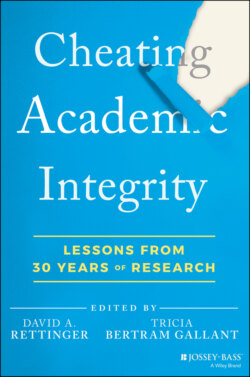Читать книгу Cheating Academic Integrity - Группа авторов - Страница 16
Trends from the time‐lag studies
ОглавлениеAs you can see in Figure 1, the first two surveys from McCabe et al. (2012) in the early 1990s are the only hint of any increase in the percentage of students engaging in cheating or plagiarism; otherwise, the trend in the three lines on the graph is consistently downward over time. Indeed, the difference between more recent prevalence rates and older prevalence rates is statistically significant within all three studies.
Figure 1
Note: Curtis and Tremayne (2021)—any of 7 forms of plagiarism at least once, McCabe et al. (2012)—any of 9 cheating behaviors at least once, Stiles et al. (2018)—any affirmative response on 3‐4‐item cheating survey.
There are three years in common in which data were collected among the three time‐lag studies: 1994 (McCabe et al., 2012 and Stiles et al., 2018), 2004, and 2014 (Curtis and Tremayne, 2021 and Stiles et al., 2018). Both McCabe et al. (2012) and Stiles et al. (2018) found lower percentages of students reporting engaging in plagiarism or cheating in subsequent studies than in 1994. Similarly, Curtis and Tremayne (2021) and Stiles et al. (2018) found lower percentages of students reporting engaging in plagiarism or cheating in 2014 than in 2004.
One notable feature of Figure 1 is that even though the trends appear similar for the three studies, the level of reported plagiarism or cheating differs consistently among the studies. That is, the percentages at any common points in time are highest for Curtis and Tremayne (2021) and lowest for Stiles et al. (2018). There are two possible explanations for these differing levels of reported academic misconduct: 1) differing cohorts of students, where some cheat more frequently as a consequence of national or institutional cultural differences or 2) the different measures elicit more or less admission of misconduct. The latter is more likely.
The surveys used by Stiles et al. (2018) rely on students knowing that they have cheated or plagiarized and then reporting this behavior. However, plagiarism can be inadvertent (Mulholland, 2020). In contrast, the surveys used by McCabe et al. (2012) and Curtis and Tremayne (2021) mostly require students to recognize a behavior they may have engaged in during an assessment, rather than label that behavior as plagiarism or cheating. People may be more likely to admit to socially undesirable behaviors if they do not label them as deviant (MacDonald and Nail, 2005). In addition, the survey used by Curtis and Tremayne (2021) asks students whether they have ever engaged in behaviors that are arguably less serious, and thus likely more common, than the behaviors examined in the other two time‐lag studies. In contrast, McCabe et al.'s (2012) surveys asked students to report behavior of only the past year. Therefore, it makes sense that Curtis and Tremayne (2021) report the highest prevalence of plagiarism/cheating. Furthermore, the survey used by McCabe et al. (2012) asks about nine different behaviors as compared with only three or four in the surveys used by Stiles et al. (2018). Having more behaviors, any of which would constitute a single instance of plagiarism cheating, means that McCabe et al. (2012) would be more likely to get affirmative responses than Stiles et al. (2018).
Returning to the prevalence trends, an important question to ask is, why might the trend in academic integrity breaches be downward since at least 1994? The authors of the studies themselves offer some differing explanations. Controversially, Stiles et al. (2018) predicted that cheating might be higher among the 2014 sample because the sample is composed of “millennial” students who evince attitudes of “entitlement”. Although Stiles et al. (2018) found that students’ feelings of entitlement correlated positively with their engagement in cheating and plagiarism, this does not explain why cheating was, in fact, lower in the 2014 study, especially as there was an additional item in the 2014 survey that may have led to more cheating being reported than in their earlier surveys. McCabe et al. (2012) suggest that technological changes, including internet‐based plagiarism not covered in their survey, may account for some of the reduced rates of plagiarism and cheating. In addition, McCabe (2016) reports a relationship between institutions having honor codes and lower rates of plagiarism and cheating. Such reports of the impact of honor codes date back to McCabe and colleagues’ earlier work, and therefore, some institutions may have implemented honor codes over time in response to previous research. Curtis and Tremayne (2021) attribute the reduction in plagiarism and cheating observed in their study to specific academic integrity education modules taught at Western Sydney University, the increased use of text‐matching software, and improved assessment practices.
As the contention that millennials are more entitled, and therefore cheat more, is not borne out in Stiles et al.'s (2018) study, two likely explanations remain for why plagiarism and cheating appear to have trended downward. First, it is possible that the forms of plagiarism and cheating examined in measures created between 15 and 60 years ago are less common, and have been replaced by newer forms of cheating and plagiarism. Second, it is possible that as staff and institutional awareness of academic integrity issues has grown over time, various interventions such as citation training, text‐matching software, and honor codes may have had an impact in reducing the prevalence of plagiarism and cheating. The next two sections of this chapter will assess these possibilities as I review data on the prevalence of a newer form of academic misconduct, commercial contract cheating, and then examine the impact of interventions targeted at reducing academic misconduct.
